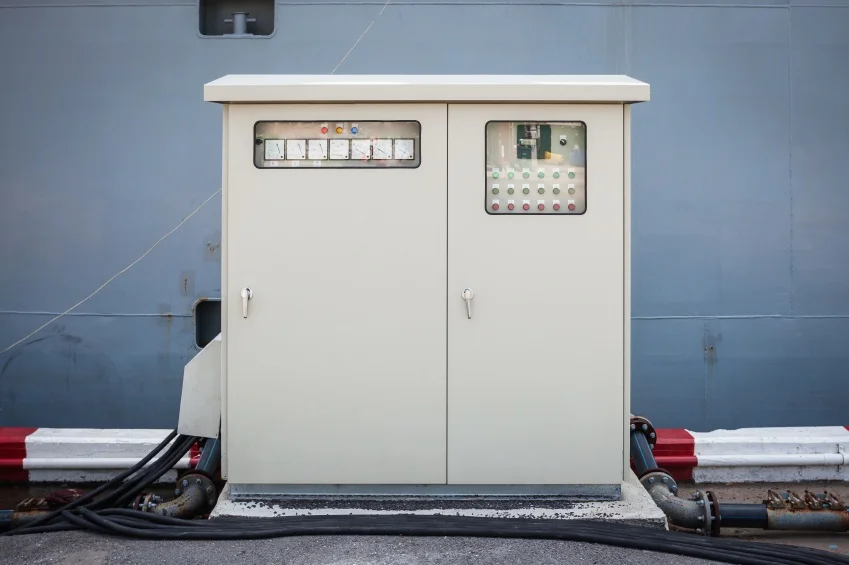Top 5 Ways Enclosure Cooling is Used

The primary function of enclosure cooling is to maintain the internal temperature of an electrical enclosure within a range that is suitable for the equipment inside the enclosure. Although it’s easier and cheaper to use ventilated enclosures, a variety of technical reasons may require the use of a sealed enclosure. In almost all instances when a sealed enclosure is necessary, it’s a requirement to use some form of enclosure cooling. Here are five top ways in which enclosure cooling is used.
-
In High Ambient Temperatures
In many locations the ambient temperature will exceed the maximum working temperature of electrical equipment, and in such situations some form of enclosure cooling is required. There are three forms of cooling generally available: filtered fans, air to air heat exchangers, and air conditioning. The first two options, fans and air to air heat exchangers, are not usually effective at high ambient temperatures because their cooling capacity depends on the thermal gradient between the enclosure and surrounding air. Enclosures using these cooling methods are always hotter than the ambient air temperature.
So, in locations where the ambient air temperature is close to, or higher than, the desired enclosure temperature, an enclosure air conditioner is the only practical solution.
-
In Dirty, Dusty Environments
Dirt and dust entering an electrical enclosure can accumulate on electrical contacts, causing contact damage and intermittent operation. Dirt will also clog moving parts, preventing operation, and in extreme cases a coating of dust can cause sensitive equipment to overheat.
In order to prevent this occurring, sealed electrical enclosures built to the appropriate NEMA standards are required. These enclosures should be equipped with a closed loop cooling system to remove heat generated by the electrical equipment. Possible solutions include air to air heat exchangers and enclosure air conditioners.
-
In The Presence Of Corrosive Chemicals
Electrical enclosures located in coastal and marine environments as well as in plants handling corrosive chemicals need protection from the corrosive effects of salt air and/or chemicals. These substances attack the various metals used in the manufacture of electrical control equipment, causing malfunction, overheating, and damage.
Electrical enclosures built for use in such environments should be completely sealed and are generally made from stainless steel. Only closed loop cooling solutions should be used and they must be built to the same standards as the enclosures. Refrigeration coils, filters, fans, and other fittings that are exposed to the environment should be protected using appropriate corrosion protection or built from materials that resist the corrosive chemicals present.
-
If Wash Downs Are Required
Some industries such as food preparation and pharmaceutical plants operate to high hygiene standards. To prevent contamination, growth of bacteria, or infection, these plants are subject to regular washing down using disinfectants and water. The chemicals used may be slightly corrosive.
Electrical enclosures within these areas are subject to wash downs and have to be fully sealed. In order to withstand the effects of high pressure washing equipment, these enclosures must be built to NEMA 4X standards. Enclosure cooling equipment used in these plants must also meet NEMA type 4X requirements and tolerate the effects of chemicals and resist high pressure washing equipment.
-
For Outdoor Enclosures
Outdoor equipment has to withstand rain, wind, dust, and other adverse weather-related conditions. Although it is not mandatory that such equipment is fully sealed, the design must ensure that moisture cannot enter the enclosure, and if dust is an issue, there should be adequate protection against the entry of dust. Another factor to consider is the effect of solar radiation, which can significantly add to the enclosure’s heat load.
When all these aspects are taken into account, the most robust and economical solution is frequently a sealed NEMA 4 electrical enclosure equipped with a closed loop enclosure air conditioner that has sufficient capacity to counter the effects of solar radiation as well as the heat generated by the electrical equipment.
Enclosure Cooling Protects In All Environments
There are many instances where enclosure cooling solutions make it possible to install electrical enclosures in adverse environments and ensure that equipment runs cool, is protected from the environment, and operates reliably. If you need help solving an electrical enclosure environmental problem, speak to one of Thermal Edge’s sales team membersand discover how our advanced cooling solutions can help you.


